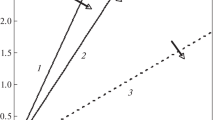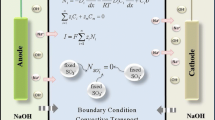Summary
Solute uptake in many cells is characterized by a series of additive Michaelis-Menten functions. Several explanations for these kinetics have been advanced: unstirred layers, transport across more than one membrane, effects of solute concentration on membrane potential, numerous carrier systems. Although each of these explanations might suffice for individual cases, none provides a comprehensive basis for interpretation of the kinetics. The most common mechanism of solute absorption involves cotransport of solute with a driver ion. A model is developed in which solute and driver ion bind randomly to a membrane-bound carrier which provides a single transmembrane pathway for transport. The kinetic properties of the model are explored with particular reference to its capacity to generate additive Michaelian functions for initial rate measurements of isotopic solute influx. In accord with previous analysis of ordered binding models (Sanders, D., Hansen, U.-P., Gradmann, D., Slayman, C.L. (1984)J. Membrane Biol. 77:123), the conventional assumption that transmembrane transit rate-limits transport has not been applied. Random binding carriers can exhibit single or multiple Michaelian kinetics in response to changing substrate concentration. These kinetics include high affinity/low velocity and low affinity/high velocity phases (so-called “dual isotherms”) which are commonly observed in plant cells. Other combinations of the Michaelis parameters can result incis-(substrate) inhibition. Despite the generality of the random binding scheme and the complexity of the underlying rate equation, a number of predictive and testable features emerge. If external driver ion concentration is saturating, single Michaelian functions always result and increasing internal substrate concentration causes uncompetitive inhibition of transport. Numerical analysis of the model in conditions thought to resemble those in many experiments demonstrates that small relative differences in a few key component rate constants of the carrier reaction cycle are instrumental in generation of dual isotherms. The random binding model makes the important prediction that the contributions of the two isotherms show opposing dependence on external concentration of driver ion as this approaches saturation. In the one case in which this dependence has been examined experimentally, the model provides a good description of the data. Charge translocation characteristics of the carrier can be determined from steady-state kinetic data on the basis of the response of substrate flux to modulation of internal driver ion concentration. The application of the model to dual isotherm kinetics is discussed in relation to “slip” models of cotransport, in which the carrier is assumed to have the capability to transport substrate alone or with the driver ion. A method for distinguishing between the two models is suggested on the basis of measurement of charge/solute transport stoichiometry as a function of external driver ion concentration.
Similar content being viewed by others
References
Bange, G.G.J. 1979. Multiphasic kinetics in solute absorption: An intrinsic property of the transport system?Z. Pflanzenphysiol. 91:75–77
Bel, A.J.E. van, Borstlap, A.C., Pinxteren-Bazuine, A. van, Ammerlaan, A. 1982. Analysis of valine uptake byCommelina mesophyll cells in a biphasic active and a diffusional component.Planta 155:335–341
Borstlap, A.C. 1977. Kinetics of the uptake of some neutral amino acids bySpirodela polyrhiza.Acta Bot. Neerl. 26:115–128
Borstlap, A.C. 1981. Invalidity of the concept of multiphasic ion absorption in plants.Plant Cell Environ. 4:189–195
Borstlap, A.C. 1983. The use of model-fitting in the interpretation of “dual” uptake isotherms.Plant Cell Environ. 6:407–416
Borst-Pauwels, G.W.F.H. 1973. Two site-single carrier transport kinetics.J. Theor. Biol. 40:19–31
Eddy, A.A. 1978. Proton-dependent solute transport in microorganisms.In: Current Topics in Membranes and Transport. F. Bronner and A. Kleinzeller, editors. Vol. 10, pp. 279–360. Academic, New York
Eddy, A.A. 1980. Slip and leak models of gradient-coupled transport.Trans. Biochem. Soc. London 8:271–273
Ehwald, R., Meshcheryakov, A.B., Kholodova, V.P. 1979. Hexose uptake by storage parenchyma of potato and sugar beet at different concentrations and different thicknesses of tissue slices.Plant Sci. Lett. 16:181–188
Epstein, E. 1976. Kinetics of ion transport and the carrier concept.In: Encyclopedia of Plant Physiology. M.G. Pitman and U. Lüttge, editors. Vol. 2, Part B, Tissues and Organs. pp. 74–90. Springer-Verlag, Berlin
Epstein, E., Rains, D.W., Elzam, O.E. 1963. Resolution of dual mechanisms of potassium absorption by barley roots.Proc. Natl. Acad. Sci. USA 53:1320–1324
Felle, H. 1981. Stereospecificity and electrogenicity of amino acid transport inRiccia fluitans.Planta 152:505–512
Flügge, U.I., Gerber, J., Heldt, H.W. 1983. Regulation of the reconstituted chloroplast phosphate translocator by an H+ gradient.Biochim. Biophys. Acta 725:229–237
Fried, M., Noggle, J.C. 1958. Multiple site uptake of individual cations by roots as affected by hydrogen ion.Plant Physiol. 33:139–144
Gerson, D.F., Poole, R.J. 1971. Anion absorption by plants. A unary interpretation of dual mechanisms.Plant Physiol. 48:509–511
Gerson, D.F., Poole, R.J. 1972. Chloride accumulation by mung bean root tips. A low affinity active transport system at the plasmalemma.Plant Physiol. 50:603–607
Hansen, U.-P., Gradmann, D., Sanders, D., Slayman, C.L., 1981. Interpretation of current-voltage relationship for “active” ion transport systems: I. Steady-state reaction-kinetic analysis of class-I mechanisms.J. Membrane Biol. 63:165–190
Hansen, U.-P., Slayman, C.L. 1978. Current-voltage relationships for a clearly electrogenic cotransport system.In: Membrane Transport Processes. J.F. Hoffman, editor. Vol. 1, pp. 141–154. Raven, New York
Heinz, E., Geck, P., Wilbrandt, W. 1972. Coupling in secondary active transport. Activation of transport by cotransport and/or countertransport with the fluxes of other solutes.Biochim. Biophys. Acta 255:442–461
Kannan, S. 1971. Plasmalemma: The seat of dual mechanisms of ion absorption inChlorella pyrenoidosa.Science 173:927–929
King, E.L., Altman, C. 1956. A schematic method of deriving the rate laws for enzyme-catalysed reactions.J. Phys. Chem. 60:1375–1378
Komor, E., Tanner, W. 1974. The hexose-proton cotransport system ofChlorella. pH-dependent change inK mvalues and translocation constants of the uptake system.J. Gen. Physiol. 64:568–581
Komor, E., Tanner, W. 1975. Simulation of a high- and low-affinity sugar-uptake system inChlorella by a pH-dependent change in theK m of the uptake system.Planta 123:195–198
Kotyk, A. 1983. Coupling of secondary active transport with\(\Delta \bar \mu _{H^ + } \).J. Bioenerg. Biomembr. 15:307–319
Lass, B., Ullrich-Eberius, C.I. 1984. Evidence for proton/sulfate cotransport and its kinetics inLemna gibba G1.Planta 161:53–60
Laties, G.G. 1969. Dual mechanisms of salt uptake in relation to compartmentation and long-distance transport.Annu. Rev. Plant Physiol. 20:89–116
McDaniel, C.N., Lyons, R.A., Blackman, M.S. 1981. Amino acid transport in suspension-cultured plant cells: IV. Biphasic saturable uptake kinetics ofl-leucine in isolates from sixNicotiana tabacum plants.Plant. Sci. Lett. 23:17–23
Mettler, I.J., Leonard, R.T. 1979. Ion transport in isolated protoplasts from tobacco suspension cells: II. Selectivity and kinetics.Plant Physiol. 63:191–194
Niemietz, C., Höfer, M. 1984. Transport of an anionic substrate by the H+/monosaccharide symport inRhodotorula gracilis: Only the protonated form of the carrier is catalytically active.J. Membrane Biol. 80:235–242
Nissen, P. 1974. Uptake mechanisms: Inorganic and organic.Annu. Rev. Plant Physiol. 25:53–79
Page, M.G.P., West, I.C. 1981. The kinetics of the β-galactoside-proton symport ofEscherichia coli.Biochem. J. 196:721–731
Pall, M.L. 1971. Amino acid transport inNeurospora crassa: IV. Properties and regulation of a methionine transport system.Biochim. Biophys. Acta 233:201–214
Plowman, K.M. 1972. Enzyme Kinetics. McGraw-Hill, New York
Poole, R. 1978. Energy coupling for membrane transport.Annu. Rev. Plant Physiol. 29:437–460
Rybová, R., Nespürková, L., Janácek, K., Struzinský R. 1982. Sulphate-uptake isotherm of the algeHydrodictyon reticulatum.Stud. Biophys. 92:123–126
Sabater, B. 1982. A mechanism for multiphasic uptake of solutes in plants.Physiol. Plant. 55:121–128
Sanders, D. 1980. Control of Cl− influx inChara by cytoplasmic Cl− concentration.J. Membrane. Biol. 52:51–60
Sanders, D. 1984. Gradient-coupled chloride transport in plant cells.In: Chloride Transport Coupling in Biological Membranes and Epithelia. G.A. Gerencser, editor. pp. 63–120. Elsevier, Amsterdam
Sanders, D., Hansen, U.-P. 1981. Mechanism of Cl− transport at the plasma membrane ofChara corallina: II. Transinhibition and the determination of H+/Cl− binding order from a reaction kinetic model.J. Membrane Biol. 58:139–153
Sanders, D., Hansen, U.-P., Gradmann, D., Slayman, C.L. 1984. Generalized kinetic analysis of ion-driven cotransport systems: A unified interpretation of selective ionic effects on Michaelis parameters.J. Membrane Biol. 77:123–152
Sanders, D., Slayman, C.L. 1983. A simple origin for “dual isotherms”, based on H+ cotransport.Plant Physiol. 72 Suppl.:140
Sanders, D., Slayman, C.L., Pall, M.L. 1983. Stoichiometry of H+/amino acid cotransport inNeurospora crassa revealed by current-voltage analysis.Biochim. Biophys. Acta 735:67–76
Schneider, R.P., Wiley, W.R. 1971. Kinetic characteristics of the two glucose transport systems inNeurospora crassa.J. Bacteriol. 106:479–486
Schultz, S.G., Curran, P. 1970. Coupled transport of sodium and organic solutes.Physiol. Rev. 50:637–718
Segel, I.H. 1975. Enzyme Kinetics, Wiley & Sons, New York
Slayman, C.L., Slayman, C.W. 1974. Depolarization of the plasma membrane ofNeurospora during active transport of glucose: Evidence for a proton-dependent cotransport system.Proc. Natl. Acad. Sci. USA 71:1935–1939
Thom, M., Komor, E. 1984. H+-sugar antiport as the mechanism of sugar uptake by sugarcane vacuoles.FEBS Lett. 173:1–4
Turner, R.J. 1981. Kinetic analysis of a family of cotransport models.Biochim. Biophys. Acta 649:269–280
West, I.C. 1980. Energy coupling in secondary active transport.Biochim. Biophys. Acta 604:91–126
West, I.C., Mitchell, P. 1973. Stoichiometry of lactose-H+ symport across the plasma membrane ofEscherichia coli.Biochem. J. 132:587–592
Wright, J.K., Overath, P. 1984. Purification of the lactose: H+ carrier ofEscherichia coli and characterization of galactoside binding and transport.Eur. J. Biochem. 138:497–508
Author information
Authors and Affiliations
Rights and permissions
About this article
Cite this article
Sanders, D. Generalized kinetic analysis of ion-driven cotransport systems: II. Random ligand binding as a simple explanation for non-Michaelian kinetics. J. Membrain Biol. 90, 67–87 (1986). https://doi.org/10.1007/BF01869687
Received:
Issue Date:
DOI: https://doi.org/10.1007/BF01869687




